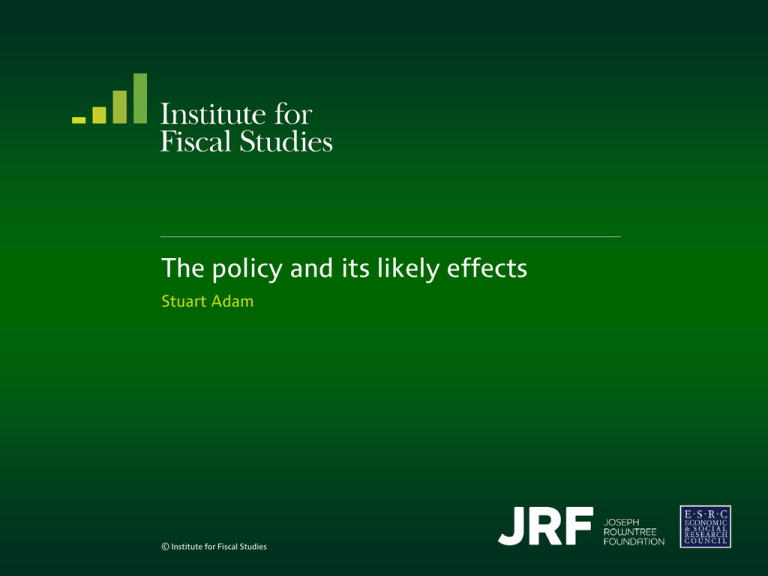The policy and its likely effects Stuart Adam
advertisement

The policy and its likely effects Stuart Adam © Institute for Fiscal Studies Council Tax Benefit – the key facts • 5.9 million recipients – More than any other means-tested benefit or tax credit – But only two-thirds of those entitled to it • £4.9 billion total cost – 2.4% of total benefit and tax credit expenditure – £15.69 per claimant per week is not large relative to other benefits • Administered by local authorities but rules set by central government • Maximum entitlement is the household’s council tax bill – Reduced by 20p per £1 of net income above a threshold – Two thirds of claimants ‘passported’ to full entitlement by receipt of another benefit © Institute for Fiscal Studies An example of CTB entitlement by income Weekly benefit received £25 CTB reduced by 20p for each £1 of income above assessed needs £20 CTB covers full council tax bill £15 £10 £5 Assessed needs £0 0 50 100 150 Weekly net income © Institute for Fiscal Studies 200 250 £45 9% £40 8% £35 7% £30 6% £25 5% £20 4% £15 3% £10 2% £5 1% £0 0% Income Decile Group Average council tax (left axis) Average CTB entitlement (left axis) Average CTB received (left axis) Gross council tax liability (right axis) Net council tax liability, with non take-up of CTB (right axis) Net council tax liability, full take-up of CTB (right axis) © Institute for Fiscal Studies % of net income £ per week Distributional impact of council tax and CTB £45 9% £40 8% £35 7% £30 6% £25 5% £20 4% £15 3% £10 2% £5 1% £0 0% Income Decile Group Average council tax (left axis) Average CTB entitlement (left axis) Average CTB received (left axis) Gross council tax liability (right axis) Net council tax liability, with non take-up of CTB (right axis) Net council tax liability, full take-up of CTB (right axis) © Institute for Fiscal Studies % of net income £ per week Distributional impact of council tax and CTB £45 9% £40 8% £35 7% £30 6% £25 5% £20 4% £15 3% £10 2% £5 1% £0 0% Income Decile Group Average council tax (left axis) Average CTB entitlement (left axis) Average CTB received (left axis) Gross council tax liability (right axis) Net council tax liability, with non take-up of CTB (right axis) Net council tax liability, full take-up of CTB (right axis) © Institute for Fiscal Studies % of net income £ per week Distributional impact of council tax and CTB £45 9% £40 8% £35 7% £30 6% £25 5% £20 4% £15 3% £10 2% £5 1% £0 0% Income Decile Group Average council tax (left axis) Average CTB entitlement (left axis) Average CTB received (left axis) Gross council tax liability (right axis) Net council tax liability, with non take-up of CTB (right axis) Net council tax liability, full take-up of CTB (right axis) © Institute for Fiscal Studies % of net income £ per week Distributional impact of council tax and CTB £45 9% £40 8% £35 7% £30 6% £25 5% £20 4% £15 3% £10 2% £5 1% £0 0% Income Decile Group Average council tax (left axis) Average CTB entitlement (left axis) Average CTB received (left axis) Gross council tax liability (right axis) Net council tax liability, with non take-up of CTB (right axis) Net council tax liability, full take-up of CTB (right axis) © Institute for Fiscal Studies % of net income £ per week Distributional impact of council tax and CTB Criticisms of CTB • Complexity and non-take-up – One in three eligible families do not claim their entitlement • Weakens incentives to work – Small effect on average; more significant for some groups • Weakens incentives to save in certain forms • An artificial incentive for claimants to live in bigger properties • Weakens local accountability and distorts LAs’ incentives – Spending an extra £1 requires raising less than £1 from local residents © Institute for Fiscal Studies The policy • CTB will be abolished from April 2013 • LAs in England, and the Scottish and Welsh governments, given grants to run their own rebate schemes instead – But pensioners in England will get current, nationally set, entitlements – Scotland and Wales both decided to operate centralised schemes • Grants will be 90% of what unreformed CTB would have cost – We assume 90% in each LA and in Scotland and Wales – After we went to press, the government proposed min & max cuts as % of total spending, illustrated as affecting only 14 LAs. We ignore this. • Free to spend more or less than these grants on rebate schemes – Scotland: maintain existing entitlements, find savings elsewhere – Wales: pass on the 10% cut to claimants – but not yet decided how We will publish a separate report on options for Wales in June – What will English LAs do? © Institute for Fiscal Studies Localising support for council tax Two stated aims of localisation: 1. Allow local variation, to reflect local priorities 2. Give LAs incentives to promote employment and growth Localisation will further these aims But will also have a variety of other effects We identify four types of effects: • Consequences of having local variation • Adding risk to LA finances • Incentives for LAs • Administration costs and incentives in two-tier areas © Institute for Fiscal Studies Consequences of local variation • Localisation will allow schemes to reflect local priorities • LAs may also be able to learn from a wider variety of experiences • The end of a nationally uniform income safety-net • Reduced transparency • Increased bureaucracy © Institute for Fiscal Studies Adding risk to local authority finances • LAs will receive fixed grants instead of having actual costs refunded • So face shortfall (surplus) if cost higher (lower) than expected – eg change in unemployment or take-up • If shortfall, only option is to draw on reserves – Cannot borrow or increase council tax in-year – If insufficient reserves, would have to cut spending for rest of the year • LAs with low reserves may want to budget with extra caution – Find savings >10% to leave a cushion and hope to build up reserves • Risk accentuated by (partial) localisation of business rates – eg closure of major local employer brings two sets of costs • Unallocated reserves average 74% of CTB across English LAs – But only 3% of total spending (<1% in 25 Las) © Institute for Fiscal Studies Incentives for local authorities (1) • LAs will receive fixed grants instead of having actual costs refunded • So they have an incentive to reduce the cost of rebates • There are many ways to do this – Try to increase employment and incomes among claimants – Discourage claimants from living in the area – Discourage development of low-value properties – Don’t promote take-up of rebates – Reduce payments made due to error and fraud – Reduce council tax rates • Some of these remove undesirable distortions; others create them • Difficult to say how far LAs will act on these incentives © Institute for Fiscal Studies Incentives for local authorities (2): future grants • Strength of incentives will depend on how grants set in future – Government has not yet decided on this • If grants adjust to reflect changing cost of rebates, gain from reducing costs only temporary – More frequent adjustments weaker incentives • Fixing grants for long periods targets changing needs less closely • Fixing grants gives LAs more certainty how much they will receive – But predictable adjustments may give more certainty in overall budget • One of the most important decisions the government has yet to take © Institute for Fiscal Studies Admin costs and incentives in two-tier areas • Shires of England have two tiers of local government – County councils span several district councils – District councils administer council tax, but keep <15% of the revenue • District councils will design and administer new rebate schemes – They pay/keep 100% of changes in administrative costs – But less than 15% of changes in entitlements, on average • In the shires, administration of CTB is 6% of the total cost but 30% of the cost to district councils An incentive to focus disproportionately on minimising admin costs – Even at the expense of other objectives • Again, not clear how far they will act on these incentives © Institute for Fiscal Studies Scale of the cuts • Funding being cut by £480m per year: £19 per household • But not £19 per household everywhere – Cut proportional to spending on CTB © Institute for Fiscal Studies Annual funding cut per dwelling, by region London North East North West West Midlands Yorkshire East Midlands South West South East East Anglia England Wales Scotland £0 £5 £10 £15 Annual cut per dwelling © Institute for Fiscal Studies £20 £25 Distribution of funding cuts per dwelling across LAs £40 Annual cut per dwelling £35 £30 £25 £20 £15 £10 £5 £0 0% 10% 20% 30% 40% 50% 60% 70% % of LAs with cut per dwelling below this level © Institute for Fiscal Studies 80% 90% 100% Scale of the cuts • Funding being cut by £480m per year: £19 per household • But not £19 per household everywhere – Cut proportional to spending on CTB • No obligation to spend exactly the amount of the grant on rebates – Wales spending exactly the grant; Scotland protecting all claimants – What about LAs in England? • If protect all entitlements, would require savings elsewhere: – 1.9% increase in council tax rates or 0.4% cut in local service spending • If don’t find any savings elsewhere: – 19% cut in support for working-age claimants on average – Higher where pensioners account for a larger share of CTB © Institute for Fiscal Studies Cuts in working-age support, by region Assuming cuts fully passed on to claimants East Anglia South West East Midlands North East Yorkshire South East West Midlands North West London England 0% 5% 10% 15% % reduction in working-age support © Institute for Fiscal Studies 20% 25% Distribution of cuts in working-age support England only, assuming cuts fully passed on to claimants Exceeds 25% for 1 in 10 LAs % cut in working-age support 40% 35% 33% in East Dorset and in Craven, North Yorkshire 30% 25% 20% 15% 14% in Hackney and in Tower Hamlets 10% 5% 0% 0% 10% 20% 30% 40% 50% 60% 70% 80% 90% % of LAs with cuts in working-age support below this level © Institute for Fiscal Studies 100% Summary • Localisation and cuts are two distinct policy choices • Localisation will have a range of effects – Allow schemes to reflect local priorities – Reduce transparency and increase bureaucracy – Give LAs an incentive to reduce cost of rebates – in a number of ways • Scale of the cut varies across Britain – Might not all be passed on to claimants of council tax support – If passed on, in England implies bigger % cuts for working-age claimants where pensioners account for a larger share of CTB – So how might LAs design new rebate schemes to make savings? © Institute for Fiscal Studies




